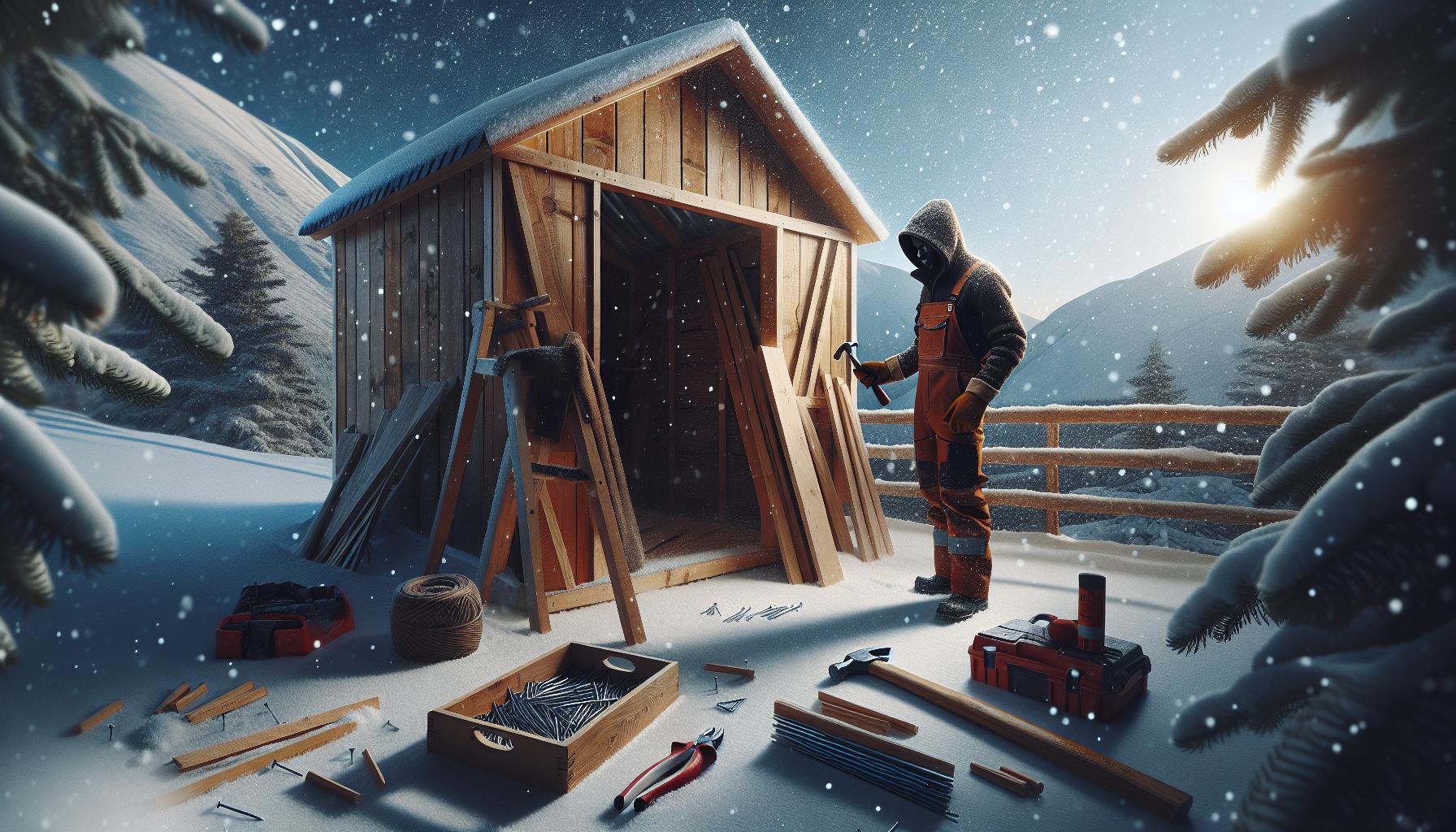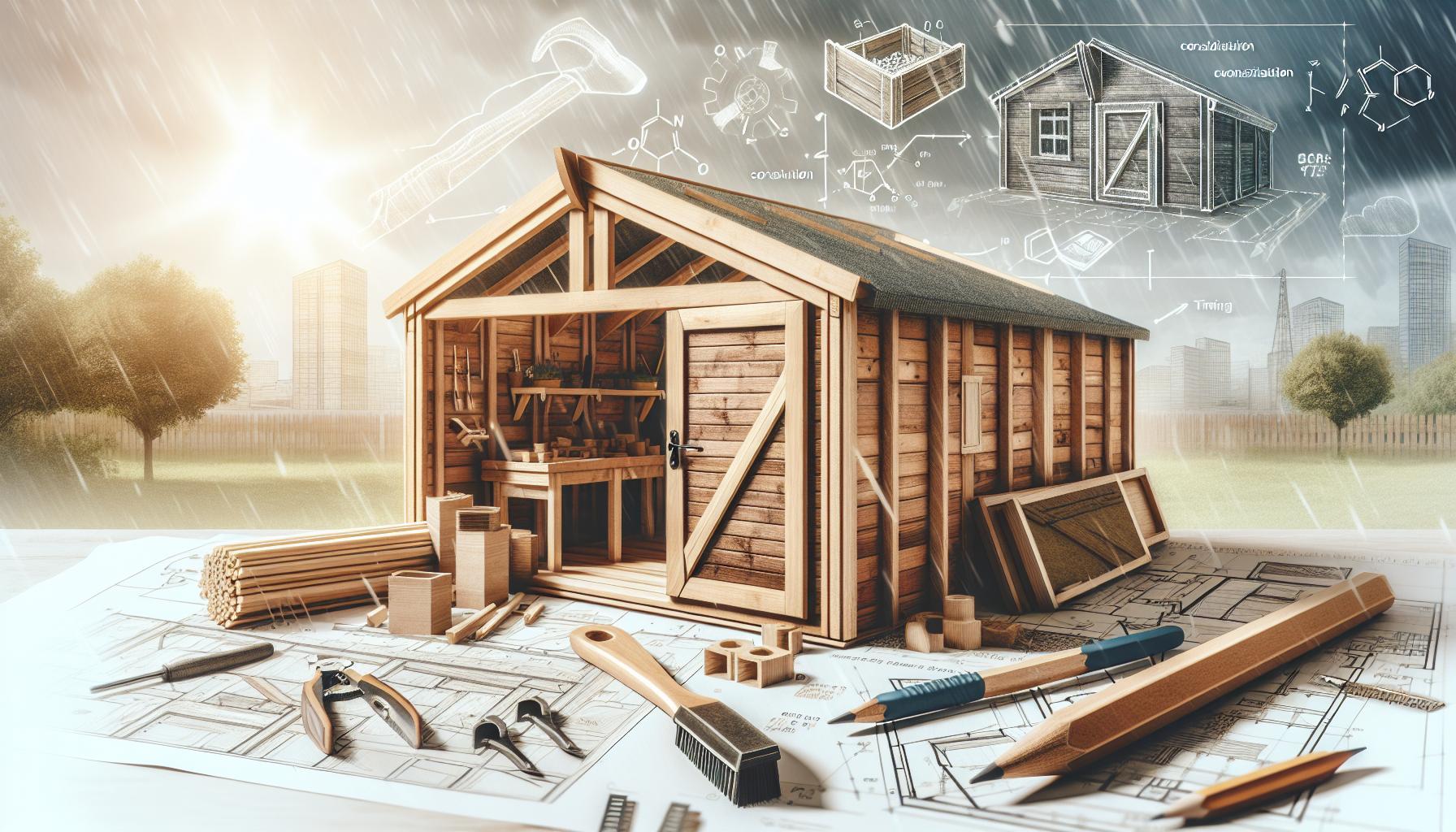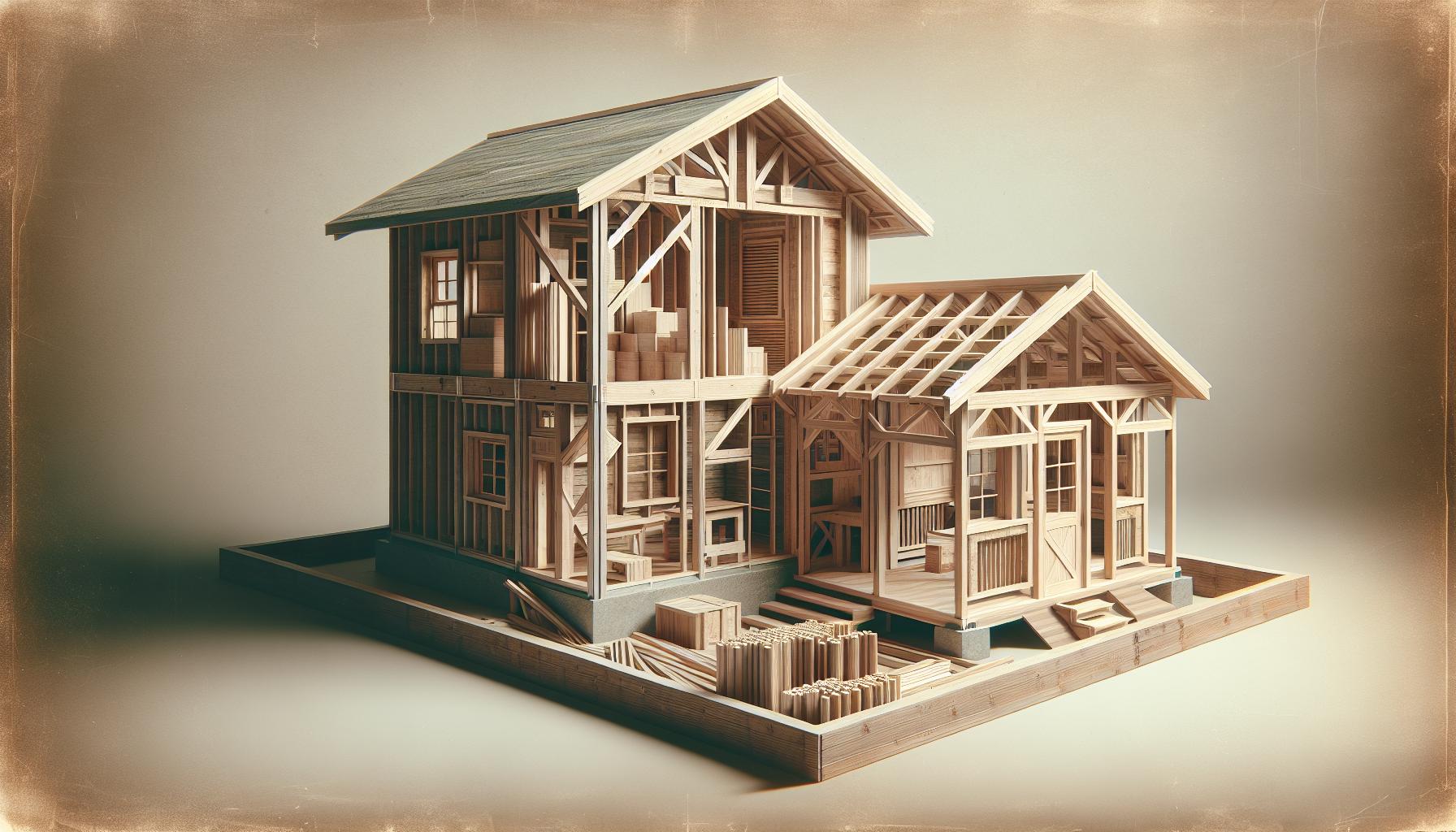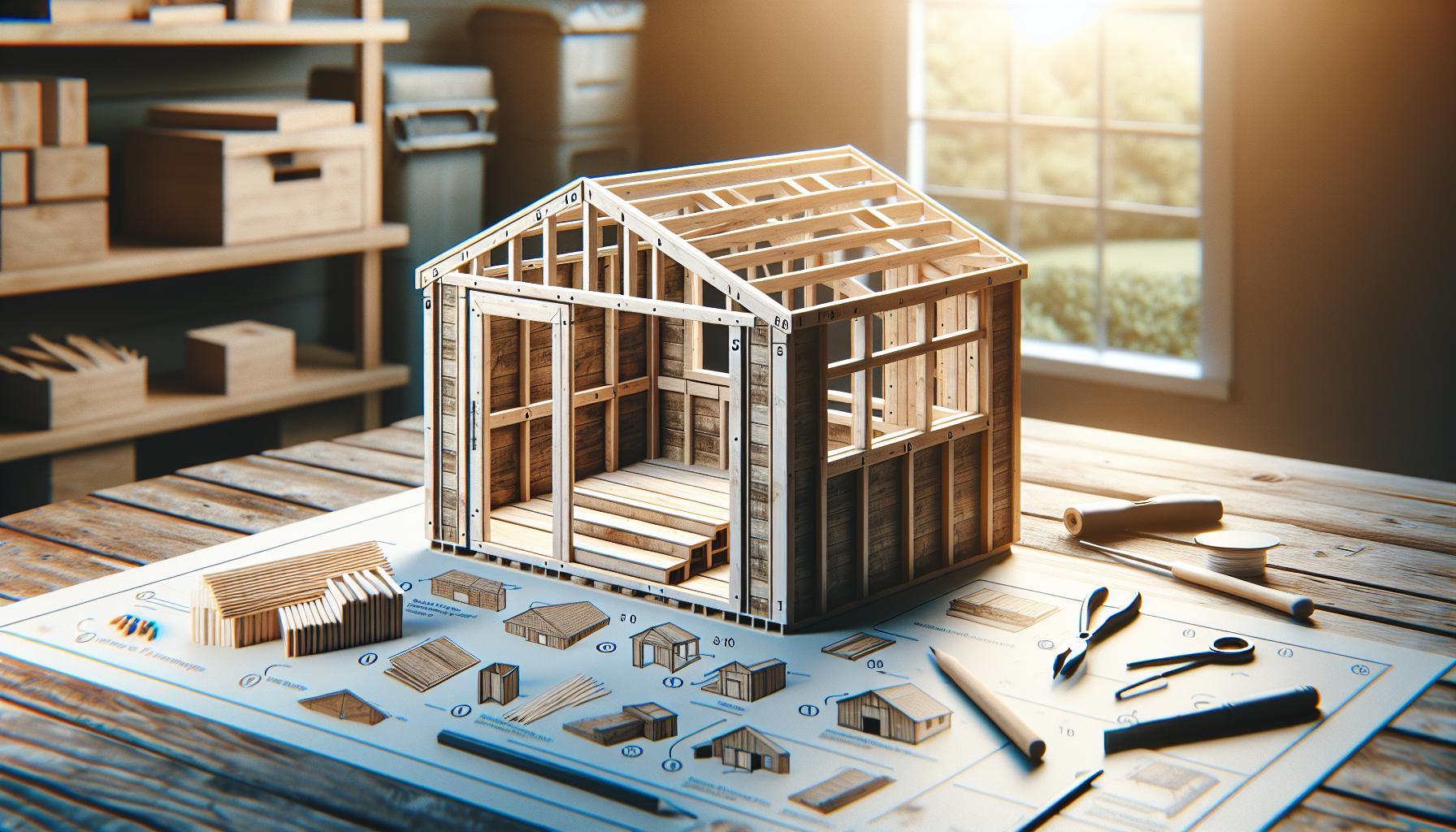Winter may not seem like the ideal time for outdoor projects, but building a shed during the colder months is entirely feasible with the right approach. Understanding how to navigate freezing temperatures can save you time and ensure your structure withstands harsh weather.Embrace thes cold weather construction tips to make your shed-building experience accomplished and efficient.
Understanding the Challenges of Winter Shed Construction
Building a shed during winter can be a daunting yet rewarding undertaking. The cold weather presents unique challenges that not only affect the construction timeline but also the materials used and the overall quality of the build. Understanding these challenges is crucial for any DIY enthusiast or professional builder considering your options.
Temperature Fluctuations and Material Behaviour
Cold temperatures can substantially impact the properties of construction materials. For instance,wood tends to shrink and contract,making it susceptible to warping and splitting.It’s essential to choose the right type of wood, preferably treated or engineered options that can withstand temperature variations. If using nails or screws, be aware that they may not grip as tightly in frigid conditions, which can lead to structural weaknesses later. To mitigate these effects,consider pre-drilling holes or using construction adhesives designed for low temperatures.
Site Readiness and Safety Concerns
Snow and ice can hinder site access, making it difficult to transport materials and equipment. Additionally, the risk of slips and falls increases significantly on icy surfaces. Preparing your worksite by clearing snow and laying down traction mats or sand can definitely help prevent accidents. Investing in non-slip footwear is also an excellent precaution for anyone working onsite. It’s advisable to carefully plan your build schedule, allowing for potential weather delays. Always prioritize safety by checking the weather forecast before working outdoors and adjusting your plans accordingly.
Adapting Techniques for Success
Cold weather construction requires adjustments in techniques to ensure that projects remain on track without compromising quality.such as,if pouring concrete,using hot water in the mix can definitely help it cure properly despite the temperature.When painting or finishing surfaces, ensure that temperatures are above the manufacturer’s recommendation to avoid issues with adhesion and drying. Additionally, using portable heating solutions can create a more comfortable work habitat, allowing for better focus and efficiency.
Proper planning and adaptation are key when tackling the question of “Can You Build a Shed in Winter?” By recognizing and preparing for the challenges associated with cold weather construction, builders can achieve a successful and satisfying project outcome. Engaging with winter shed construction can not only multiply your skills but also yield a durable and functional structure that stands the test of time.
Essential Materials for Cold Weather Building
Building in cold weather presents unique challenges and requires careful consideration of materials to ensure durability, insulation, and structural integrity. Understanding which materials are moast effective in frigid conditions can significantly influence the success of your construction project, especially if you’re wondering about the feasibility of erecting a shed during winter.
When planning for cold-weather construction, the choice of materials should prioritize thermal insulation and moisture resistance. Natural stone, clay bricks, and concrete blocks are excellent options for creating sturdy structures that can withstand harsh conditions. These materials not only provide strength but also have insulating properties that can reduce heat loss, making them ideal for environments that experience extreme cold. Additionally, using wood finishes and interior plaster can further enhance insulation, providing a warm aesthetic while contributing to energy efficiency [1[1].
Key Considerations for Material Selection
- Insulation: Ensure that the materials used prevent thermal bridging, which can lead to heat loss. Insulated concrete forms (ICFs) are another innovative option for wall construction in cold climates.
- Moisture Management: Select materials that resist water absorption to avoid structural damage from freeze-thaw cycles. As a notable example,certain sealants and moisture barriers are essential when working with wood.
- Foundation Stability: In winter construction, freeze-thaw cycles can affect the stability of the foundation. use reinforced footings to prevent shifting as the ground thaws and freezes.
Along with the structural materials, consider using high-quality insulation products such as rigid foam or spray foam insulation to further enhance the warmth of the building. Integrating these materials can keep your shed not only functional throughout the winter but also comfortable if you plan on utilizing it during the cold months. By using the right materials and employing proven techniques, you can effectively tackle the challenges presented by winter construction and ensure that your new shed remains durable and welcoming despite external temperatures.
Safety Precautions for Winter DIY Projects
When tackling DIY projects in the winter months, safety should be your top priority. Cold weather can pose unique challenges and dangers, from slippery surfaces to equipment malfunctions. understanding these risks and preparing accordingly can make the difference between a successful build and an accident that leads to injury or costly damages. For anyone pondering the question of whether building a shed in winter is viable,recognizing and implementing safety precautions is essential.
Essential Safety Tips for winter Projects
Working in cold temperatures can make construction tasks more daunting. Here are some key safety precautions to consider:
- Dress Appropriately: Layer your clothing to stay warm while ensuring you have freedom of movement.Wear insulated, waterproof boots and be mindful of your hands and head, which lose heat quickly.
- watch for Icy Surfaces: Snow and ice can create hazardous conditions on driveways and walkways. Always use salt or sand to improve traction and reduce your risk of slips and falls.
- Inspect Tools and Equipment: Cold weather can affect the performance of your tools. Before starting, check that everything is functioning properly, and consider using battery-operated tools, which can be more reliable in low temperatures.
- Stay Hydrated: It’s easy to forget to drink water in winter, but staying hydrated is crucial, especially if you’re active outdoors.
Planning for Daylight and Weather Changes
Daylight is limited during the winter months, so proper planning is essential. Organise your tasks to take advantage of the daylight hours, and always have alternative indoor projects lined up in case of inclement weather. If you’re building a shed, consider the forecast carefully. Sudden storms can introduce risks related to materials like unprotected wood or exposed equipment.
First Aid and Emergency Preparedness
In the event of an accident, being prepared can minimize consequences. Ensure you have a well-stocked first aid kit on-site, and keep a charged cell phone nearby in case you need to call for help. Familiarize yourself and your family with basic first aid techniques.
By following these winter safety precautions, you can confidently answer the question of whether you can build a shed in winter while ensuring a safer and more productive experience.
Tools and Techniques for Efficient Cold Weather Construction
Constructing a shed during winter may seem daunting, but with the right tools and techniques, it can be both efficient and successful. one of the essential factors in cold weather construction is ensuring your equipment and tools function optimally in lower temperatures. This requires not just appropriate gear, but also a strategic approach to tackling tasks effectively when dealing with potential ice and snow.
Essential Tools for Cold Weather Construction
When gearing up for winter projects, select tools specifically designed to withstand lower temperatures. Here’s a list of must-have items:
- Cold Weather Lubricants: Use lubricants that are designed for arctic conditions, as regular oils may become too viscous in the cold.
- Improved Insulation: Insulated gloves and boots can enhance dexterity and comfort while working.
- Heated Equipment: Invest in equipment with heated grips or consider portable heaters for your workspace.
- Winter-Specific Fasteners: some fasteners are designed to perform better in cold, preventing brittleness and breakage.
techniques for Effective Work in the Cold
Understanding how to approach work during colder months is just as critically importent as having the right tools. Here are some techniques to enhance efficiency:
- Pre-Project Planning: Have a detailed plan that outlines each step of your construction process. This ensures you and your team stay focused and can work effectively even when conditions worsen.
- Minimize Downtime: Organize your work schedule to take advantage of warmer parts of the day. This can lead to increased productivity and minimize weather-related delays.
- Monitor Material Conditions: Check the temperature limits of materials (like wood or adhesives). Some products may not set properly in freezing conditions, leading to potential structural issues down the line.
- Utilize Temporary Shelters: Set up enclosures or heated tents to provide a warmer working environment, allowing you to work consistently despite external low temperatures.
By implementing these tools and techniques, constructing a shed during winter becomes not just feasible but also efficient.With proper planning and the right equipment, you can overcome the challenges posed by cold weather and achieve your construction goals, reflecting the insights from “Can You Build a Shed in winter? Cold Weather Construction Tips.” Whether you’re a seasoned builder or a DIY enthusiast, preparing for winter construction will ultimately ensure your project adheres to both timeframes and quality standards.
Planning Your Shed build: Timing and Weather Considerations
Building a shed during the winter can be a daunting task, but with the right planning and considerations, it can also be a rewarding one. Many assume that cold weather halts construction, but with careful preparation, you can ensure a successful build even in lower temperatures. Understanding the nuances of winter weather and its impact on construction materials and methods is crucial.
Timing Your Shed Build
Selecting the right time to build a shed requires a keen awareness of local weather patterns. Aim for a window of milder winter days, typically when temperatures hover above freezing—this helps avoid complications such as frozen ground or excessive snow accumulation. Early to mid-winter frequently enough provides this opportunity before the harshest conditions set in. When planning, consider using tools like weather apps to monitor forecasts, allowing you to choose days when conditions are most favorable for construction activities.
Weather Considerations
Cold weather brings unique challenges that can affect construction timelines and methodologies. Here’s how to navigate these obstacles effectively:
- Site Preparation: Before the ground freezes, prepare your site. Clear any debris and consider using compacted gravel as a foundation, allowing for drainage and stability even under snow.
- Material Choices: Opt for materials that are suited for cold climates. Products like insulated panels with foam cores provide excellent thermal regulation and structural integrity against biting winds and snow loads [3[3].
- Work Smart: Shorter daylight hours during winter mean you should maximize your working time. Plan tasks that require full daylight,like measuring and cutting,for earlier in the day.
Building a shed in winter isn’t impossible, but it does require strategic planning to mitigate the influences of cold weather. By selecting the right materials,preparing your site ahead of time,and timing your tasks wisely,you can ensure your shed construction goes smoothly—even in the dead of winter. Leveraging these cold weather construction tips will not only enhance the quality of your build but also ensure you’re making the most of the often-overlooked winter construction season.
Insulation and Heating Solutions for a Comfortable workspace
Creating a comfortable workspace, especially in the colder months, requires careful consideration of both insulation and heating solutions. As winter approaches,it’s crucial to understand how to maintain a warm environment within your shed or workspace while ensuring energy efficiency.without adequate insulation, your efforts to heat the space can be wasted, leading to higher energy bills and discomfort.
Effective Insulation Options
Proper insulation is key to keeping your workspace warm and cozy. Here are some viable insulation strategies:
- Foam board Insulation: This rigid insulation material is effective for walls and roofing, providing high thermal resistance.
- Fiberglass Batts: Commonly used in walls and ceilings,these batts prevent heat escape and are relatively easy to install.
- Spray Foam Insulation: Ideal for irregular spaces, spray foam offers excellent air sealing properties, ensuring minimal heat loss.
Using a combination of these materials can maximize your shed’s insulation performance, making it easier to maintain a consistent temperature even during extremely cold weather.
heating Solutions for Winter Comfort
Once properly insulated, it’s critically important to select an efficient heating solution. Here are some options tailored to small spaces like sheds:
- Electric Heaters: Portable electric heaters are convenient and can be precisely controlled to maintain a comfortable temperature.
- Propane Heaters: These provide a strong source of heat but should be used with proper ventilation.
- Radiant Floor Heating: For a more permanent solution, consider installing radiant heating under the floor to provide consistent warmth that rises upwards.
Investing in quality heating equipment tailored for winter conditions will not only enhance comfort but can also support your workspace efficiency.
Combining Insulation and Heating for Best Results
The interaction between insulation and heating systems is crucial for achieving optimal comfort. A well-insulated workspace allows heaters to operate more efficiently, thus reducing energy consumption and costs. For example, if you choose radiant floor heating, adequate insulation will ensure that the heat generated is not lost to the outside, maximizing the system’s effectiveness.
Implementing these insulation and heating solutions as part of your cold weather construction tips can transform your shed into a reliable, year-round workspace. By focusing on building techniques that prioritize warmth and efficiency, you’ll create an environment conducive to productivity, regardless of the season.
Protecting Your Materials from Winter Elements
When embarking on construction projects during the winter months, it’s crucial to safeguard your materials from the harsh effects of cold weather. proper protection not only extends the life of your supplies but also ensures that your project can continue uninterrupted. in addition to battling frigid temperatures, snow and ice can wreak havoc on unprotected materials, leading to delays and increased costs.
To effectively shield your supplies, consider the following strategies:
Storage Solutions
Utilizing temporary storage units or covered areas can significantly mitigate damage.Ensure that materials such as lumber, tools, and equipment are stored in a dry, shielded location. This will prevent moisture accumulation that can lead to mold or rot. Additionally, covering scaffolding, ladders, and walkways is essential to keep them dry and reduce icy build-up, thereby minimizing hazards for workers.
- Choose insulated storage options: These facilities maintain a consistent temperature, ideal for protecting sensitive materials.
- Cover items with tarp or plastic: Make sure that any protective covers are securely fastened to withstand winter winds.
- Elevate materials off the ground: Using pallets or blocks can help prevent moisture absorption from the snow-covered ground.
Material Specific Protection
different materials require unique protection strategies. For example, if you are working with concrete, it’s important to add insulating blankets to prevent freezing during the curing process. Similarly, wood should be kept dry, as wet conditions can lead to warping and splintering.Here’s a swift reference table to help:
| Material | Protection Method |
|---|---|
| Wood | Keep dry, elevated storage, cover with tarps |
| Concrete | Use insulating blankets, maintain warm temperatures |
| Metal | Store indoors, coat with protective oil |
Implementing these practical tips will not only ensure your materials are safeguarded against winter elements but also streamline the construction process, making the question of “can You Build a Shed in Winter? cold Weather Construction Tips” a resounding yes! With the right precautions, winter can be just as productive as any other season for construction projects.
Tips for Maintaining Motivation and Momentum in Cold Conditions
Working on construction projects during the chilly months can present unique challenges, but maintaining your motivation and momentum is crucial for progress. Recognizing that winter temperatures can sap your energy and inspiration, it’s essential to adopt strategies that keep your spirits high and your project on track when considering building a shed in winter. Staying proactive and organized will make a important difference in your productivity levels.
Establish a Routine
Consistency breeds motivation. Design a daily schedule that aligns with your construction goals and the specific tasks you need to accomplish. By adhering to a structured routine, you can create a sense of normalcy and purpose, which will help combat winter’s dreariness. For example, dedicate the mornings to preparing tools and materials and reserve the afternoons for project work. This balance allows you to break tasks into manageable segments,making the overall project feel less overwhelming.
Utilize Positive Reinforcement
Celebrate even the smallest achievements throughout your construction process. Completing milestones, such as laying the foundation or framing the walls, deserves recognition. Consider rewarding yourself with something enjoyable, like a warm drink or a short break to engage in a favorite hobby. This kind of positive reinforcement not only enhances motivation but also makes the work feel more rewarding.
Optimize Your Working Environment
A conducive working environment is paramount in cold conditions. To ensure that your workspace promotes productivity, focus on the following:
- Temperature Control: Keep your workspace heated and comfortable. Using portable heaters can ward off the chill and maintain a more inviting atmosphere.
- Proper Gear: Dress in layers, ensuring you have good thermal gloves and boots. This will help you stay warm while allowing full dexterity when working with tools.
- Organized Workspace: Declutter your work area regularly. An organized space reduces distractions and helps you stay focused on your tasks.
Stay Social and Collaborative
Don’t forget the power of community. Engage with fellow DIY enthusiasts or neighbors who share your interests. You can organize group projects or simply share progress updates. Collaborating not only makes the tasks more enjoyable but also provides a support network that can keep you motivated when the winter days feel long and monotonous.
By implementing these strategies, you can effectively maintain your motivation and momentum for building a shed during the cold months. Embrace the challenges winter presents, and transform them into opportunities for growth and development in your construction skills.
Frequently asked questions
Can You Build a Shed in Winter? Cold Weather Construction Tips?
Yes, you can build a shed in winter, but it requires specific considerations to ensure the process is successful and safe. cold weather can affect materials and construction methods.
When building during winter,pay attention to the temperature and moisture levels as they can influence how materials behave. For example, wood can expand and contract with changes in temperature, potentially leading to a poor fit if the shed is not designed for such conditions.
what materials are best for building a shed in winter?
The best materials for winter shed construction are those that can withstand cold conditions,such as treated wood and weather-resistant roofing materials.
Treated lumber is less likely to warp or crack, providing longevity. Additionally, materials that resist moisture, like synthetic roofing underlayment, help prevent damage from ice and snow accumulation.
how can cold weather affect shed construction?
Cold weather can slow down the curing process of adhesives and paint, making it crucial to allow extra time for these materials to set.
If the temperature drops too low, some treatments won’t adhere properly. It’s essential to check product labels for temperature recommendations, ensuring you choose the right materials for the weather conditions.
Can I use concrete for a shed foundation in winter?
using concrete in winter is possible, but requires specific precautions to prevent freezing and ensure proper curing.
If the temperature is below 50°F (10°C), you should use heaters or blankets to keep the concrete warm during curing. Additionally, winter-grade concrete mixtures can be beneficial as they are designed for colder conditions.
What are some cold weather construction tips for DIYers?
some effective cold weather construction tips include working during the warmest part of the day and dressing in layers to stay warm.
Avoiding tasks that require precise measurements when it’s too cold can help prevent mistakes. Additionally, consider pre-cutting materials at home, so you can limit time spent outdoors in the cold.
Why does moisture management matter in winter shed building?
Moisture management is crucial in winter shed building to prevent material degradation and structural issues.
Snow and ice can lead to water infiltration, causing mold and rot in untreated wood. Using moisture barriers and ensuring proper drainage around the shed can help protect your investment.
Can you insulate a shed for winter use?
Yes, insulating a shed can significantly improve its usability during winter by maintaining internal temperatures.
Using insulation materials like fiberglass batts or foam board can help create a comfortable environment for tools or even a workspace. Additionally, sealing gaps around windows and doors can enhance energy efficiency.
To Conclude
building a shed in winter can be a rewarding challenge, and with the right preparation, you can tackle it successfully despite the cold. Remember that weather conditions such as wind, rain, and snow can complicate the construction process, so take the time to plan carefully. Consider using materials that can withstand fluctuating temperatures and ensure your foundation is solid to prevent frost heave. Incorporating weather-resistant features, like a vapor barrier, will help protect your shed from moisture issues that often occur in colder months








